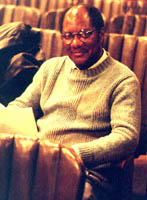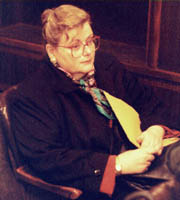Some good news, some bad news, one giggle and one treat:
Transit. OSA won the right to represent Transit Authority Staff and Associate Staff Analysts by a vote of 97 to 57. At the same time, we lost our fight to represent MaBSTOA Analysts by a vote of 77 to 95.

The major difference between "TA" and "OA" is civil service status. Most, but not all "TA" Analysts are permanent civil servants, but no "OA" Analyst is a permanent civil service employee. When "OA" Analysts do pass the Staff Analyst exam, they are picked up by the TA and appointed, although in most cases the work remains the same.
With the advantage of hindsight, it is clear that our campaign did not pay sufficient attention to the differences between TA and OA. We will correct that error eleven months from now when we are allowed to begin again. In the meantime, as always, our best campaign approach is to maintain a responsive and energetic union acting effectively on your behalf.
The nice part is that we have 244 new brothers and sisters, and that our union is one large step closer to bringing collective bargaining rights to all publicly employed Analysts.
Our first task is to help the new group choose local leaders, then form a bargaining team and set forth contract demands. At some point this Spring we will also throw a small party in celebration of our partial win.
We all owe a vote of thanks to OSA's small army of volunteer organizers and courageous on-location activists. Over the past ten years, more civil servants have been organized in New York City by OSA than by any other public union. (Note: there are over one hundred municipal unions in our city.)
When OSA loses an election, we immediately begin to plan to do it again, only better.
It is expected that the TA will bargain fiercely against us this year, but our goals are simple. We would like our members at TA to do as well as our members everywhere else. Surely that is not asking too much.

Monies. One minor point, but a pleasing one -- final calculations on our longevity increase due on 6/1/99 gave a total of $6 more (annually) for the ten and fifteen year longevities. The new total for NYC, OTB, NYCHA, Hospitals and Board of Ed Analysts will be $1013 after ten years, a total of $2026 after fifteen and another $998 at the twentieth year.
More about Money. Jay Warshofsky's page of calculations in the December mailing was fine except for one omission. Jay failed to mention the fact that the ten and fifteen year longevities do not count for pension or compounding of raises until fifteen months after one starts to be paid the differential. As a result, some members claimed the added money through payroll complaint forms, but were not actually entitled (at that point) to the compounding.
The matter then became more complicated, since our local unit contract was not then signed -- it is now -- and no copies of it were in the hands of various payroll offices. Therefore, some folks due the compounding were told by their agencies that they were not due the extra pennies involved.
Finally, although we got more phone calls and mail on this topic than any other in the past six months, at least one member called to protest the union wasting time on pennies. Well, we are Analysts and do like everything to be correctly done, but actually there is an even better reason to spend time on this topic.

In June of this year, our 10 and 15 year longevities increase and a 20 year longevity is added. The 10 and 15 are pensionable and subject to compounding fifteen months after receipt, but the 20 is only pensionable after two years and is never used for compounding contract raises.
Below, at the end of this month's News From OSA, we have provided the actual words of our contract as it pertains to longevity at the 10 and 15 year points.
One last point, note that the number shown on your pay stub for longevity differential does not change. If you get an extra 44 cents (as per Jay's example) it turns up in the base pay part of your pay stub; it does not change the $14.54 (or $379 per year) listed as a differential.
The Giggle comes from HRA's code of conduct issued on December 17, 1998. Such codes are preachy and they are often demeaning in their implication that civil servants have so little common sense that we must be told the most obvious rules of politeness.
HRA's latest production descends below the norm of such pontification by including new occasions for sin, some entirely unexpected and even unimaginable by staff heretofore.
Did you know that if you were hired by HRA after March 16, 1990 you were required to read and conform to the provisions of Chapters 49 and 68 of the New York City Charter? If you have not done so, it is too late. The code is clear that you had only ten days to find those documents and read them. Too bad.

Another section of this code includes the standard self serving warnings for staff not to testify before any other branch of government without giving prior written notice to the Commissioner. If Ken Starr should subpoena you to tell all you know about Monica and the HRA hierarchy, your first step is to send a memo to that same hierarchy. The code of conduct does not state why this is necessary but we figure it gives everyone time to return any innocent gifts.
Page four delivers pious folderol about our not soliciting or accepting benefits in return for our vote. This rule clearly presumes employees for the exempt class are being found in the cabbage patch rather than being appointed by elected officials.
One daring aspect of this particular code is contained in a lovely bit that appears to challenge the findings of the Allied court at Nuremberg. Page 5, subsection 20 of section III informs us that we must, immediately, obey all orders of our superiors, oral or written, "despite advice offered by labor representatives." We love the part about labor representatives.
Now, most religions, and all international courts (never mind the unions) would have a problem with any agency code which insists that even illegal, morally repugnant and positively dangerous or suicidal orders must be obeyed.
Our always faithful U.S. Marine Corps does allow a subordinate to demand an order in writing, but not the HRA Code of Conduct. Boys and girls, HRA is being really tough these days.
But wait...there is still more. Our favorite part of EO 451, the HRA code of conduct, is found at the end, on page nine, in section VI; the Oath of Office.
We are reminded that we all (except for labor class employees) took an oath of office to support the Constitution of the State and the Nation.
We did? No we didn't. No one currently working at the union office remembers ever being asked to sign up to support the state constitution nor had we even suspected that it was in any danger at all. We checked with the retirees and learned that some such oath was exacted to try to deny jobs to Communists in the 1950's during the height of the McCarthy era. Still further research led us to uncover the source of the oath, a local State law (574) passed in May of 1917. It was probably to deny jobs to pacifists or perhaps immigrants of German, Turkish or Astro-Hungarian background. Why did they exempt the labor class? Class politics?
All this, of course, reduces our anger about the code of conduct, greatly. It is hard to stay angry while we are giggling. Next time HRA might consider sharing its promulgations with the union before issuance, but then again maybe it's more fun this way.

Our treat is a free movie, one that you probably have never seen before. OSA provides desk space, periodically, to Elsa Rassbach, head of Made in U.S.A. Productions, a labor-oriented film company. Ms. Rassbach's first film The Killing Floor will be shown on Thursday evening (3/11/99) at the OSA office and coffee and cake will be provided. Elsa herself will be present.
If we have a good attendance, OSA is seriously considering a labor film series. Ticket prices in Manhattan have now reached $9.50, so perhaps a union sponsored series might be popular. Bring a friend. It would be helpful to call Rose 212-686-1229 to let her know you're coming, so we can have enough cake to go around.
The general membership meeting will be held Thursday, March 25th at 125 Worth Street, Manhattan in the 2nd Floor Conference Room at 6:00 pm.
---------------
If you are eligible
for the 10-year longevity, don't get shortchanged!
The City of New York
seems to have shortchanged all Analysts who were eligible to collect only
the 10-year ($379) annual longevity. Analysts who receive both the 10-year
and 15-year longevity seem to have gotten the right amount.
This longevity is shown on your paycheck as:
| Description | units/hours | amount earned this penod |
| SVC/LONG/ED | 0:00 | 14.54 |
This amount is subject to the 3% contractual increase that was payable July 1, 1998. However, the City does not increase the bi-weekly $14.54 line item on the check stub. The increase of $.44 should be added to the new base pay. The result is an increase in your annual base salary of approximately $11.
The simplest way to confirm the correct amount is to compare your weekly check before and after the raise. Use a stub that includes an entire pay period. See the example we've provided below for an Associate Staff Analyst at minimum scale.
The quickest way to correct your pay is to file your agency's payroll complaint or payroll inquiry form. This procedure should be faster than filing a grievance and may ruffle fewer feathers at your agency.
The Office of Labor Relations strongly urges that members entitled to the compounding hold off on submitting payroll complaint forms until after April 15, 1999. Management will itself seek to correct any errors before that date. If you see corrections on your pay stub before April 15, do not be surprised.
Finally, while it may seem picayune to many to file for 22.5 cents a week, please remember, every penny we win is a hard-fought struggle. The principle really is important.
NOTE: Compounding of 10 and 15 year longevities only occurs 15 months after receipt.
Jay Warshofsky, December, 1998
---------------
Example for an Associate
Staff Analyst
The following example
is shown at minimum pay scale, so follow the example but insert the actual
numbers from your own paycheck.
Sample attachment
to your Payroll Inquiry or Complaint.
Don't forget to include
your name and the date.
|
bi-weekly
check
|
|
|
Actual pay Calendar Year 1997 (through 6/30/97): |
|
| Regular pay at 70 hours |
$1,791.34
|
| 10 year longevity pay |
14.54
|
|
$1,805.88
|
|
| Correct rate after 3% general increase: | |
| Old base pay |
$1,791.34
|
| Plus base pay increase (3%) |
53.74
|
| New base pay |
$1,845.08
|
| Plus 3% increase on 10 year longevity |
0.44
|
| New net base pay for 70 hours |
$1,845.52
|
| Existing 10 year longevity |
14.54
|
| New Gross Pay |
$1,860.06
|
| As actually paid on 9/4/98 payday and thereafter to date: | |
| Regular pay 70 hours |
$1,845.08
|
| 10 year longevity pay |
14.54
|
|
$1,859.62
|
|
| Net underpayment in each bi-weekly check: |
($0.44)
|
| Net underpayments since 7/1/98: | |||
| Pay period from: |
through:
|
check
dated
|
prorata
underpayment
|
| 07/01/98 (partial) |
07/04/98
|
07/10/98
|
($0.13)
|
| 07/05/98 |
07/18/98
|
07/24/98
|
(0.44)
|
| 07/19/98 |
08/01/98
|
08/07/98
|
(0.44)
|
| 08/02/98 |
08/15/98
|
08/21/98
|
(0.44)
|
| 08/16/98 |
08/29/98
|
09/04/98
|
(0.44)
|
| 08/30/98 |
09/12/98
|
09/18/98
|
(0.44)
|
| 09/13/98 |
09/26/98
|
10/02/98
|
(0.44)
|
| 09/27/98 |
10/10/98
|
10/16/98
|
(0.44)
|
| 10/11/98 |
10/24/98
|
10/30/98
|
(0.44)
|
| 10/25/98 |
11/07/98
|
11/13/98
|
(0.44)
|
| Total net underpayment as of pay period ending 11/13/98: |
($4.06)
|
||
----------------
Appendix A: Longevity Increment Eligibility Rules
The following rules shall govern the eligibility of employees for the longevity increments provided for in Article III, Section 8, of the 1995-2000 Staff Analysts, et al. agreement:
1. Only service in pay status shall be used to calculate the 10 and 15 years of service, except that for other than full time per annum employees only a continuous year of service in pay status shall be used to calculate the 10 and 15 years of service. A continuous year of service shall be a full year of service without a break of more than 31 days. Where the regular and customary work year for a title is less than a twelve month year such as a school year, such regular and customary year shall be credited as a continuous year of service counting towards the 10 and 15 years of service. If the normal work year for an employee is less than the regular and customary work year for the employee's title, it shall be counted as a continuous year of service if the employee has customarily worked that length of work year and the applicable agency verifies that information.
2. Service in pay status prior to any breaks in service of more than one year shall not be used to calculate the 10 and 15 years of service. Where an employee has less than seven years of continuous service in pay status, breaks in service of less than one year shall be aggregated. Where breaks in service aggregate to more than one year they shall be treated as a break in service of more than one year and the service prior to such breaks and the aggregated breaks shall not be used to calculate the 10 and 15 years of service. No break used to disqualify service shall be used more than once.
3. The following time in which an employee is not in pay status shall not constitute a break in service as specified in the paragraph 2 above.
a. time on a leave approved by the proper authority which is consistent with the Personnel Rules and Regulations of the City of New York or the appropriate personnel authority of a covered organization.
b. time prior to reinstatement.
c. time on a preferred list pursuant to Civil Service Law Sections 80 and 81 or any similar contractual provision.
d. time not in pay status of 31 days or less.
Notwithstanding the above, such time as specified in subsections a, b, and c above shall not be used to calculate the 10 and 15 years of service.
4. Once an employee has completed the 10 and/or 15 years of "City" service in pay status and is eligible to receive the respective longevity increment, the increment shall become part of the employee's base rate for all purposes except as provided in paragraph 5 below.
5. The respective longevity increment shall not become pensionable until 15 months after the employee becomes eligible to receive such increment. Fifteen months after the employee becomes eligible to receive the longevity increment, such longevity increment shall become pensionable, and as part of the employee's base rate, shall be subject to the general increase provided in Article III, Section 3, of this agreement.